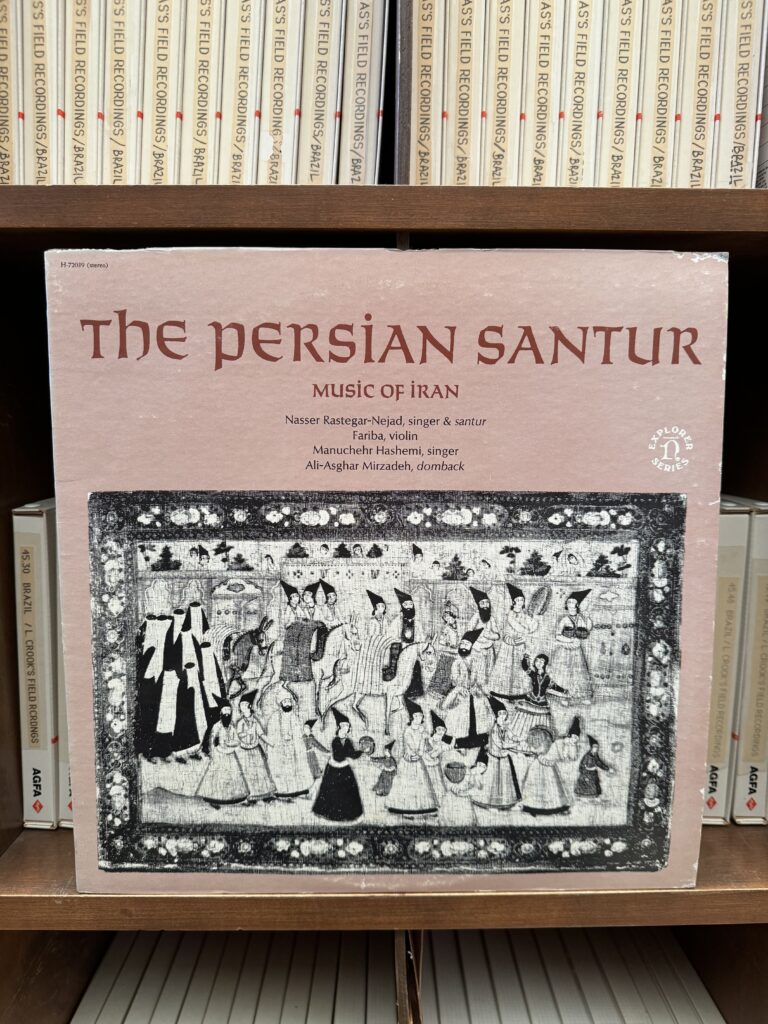This is the seventh blog post in a series featuring behind-the-scenes discoveries from the Ethnomusicology Archive & Lab at UT Austin’s Butler School of Music.
BY HAMIDREZA FALLAHI, PHD STUDENT
Nowrooz, the Persian new year, occurs on the vernal equinox and marks the first day of the astronomical spring. Nowrooz celebrations are important to Persians and many of the Middle Eastern and Central Asian communities, during which families and friends gather together and celebrate the rebirth of nature – as the symbol of a new day and a new life.
I have personally experienced 30 Nowrooz celebrations in my home country, Iran. I remember all of them with sweet – and occasionally bitter– memories of the new year along with my relatives, friends, and the vibrant atmosphere of Shiraz, my beautiful hometown. But this is my first time celebrating Nowrooz in exile: I’m in Austin, far away from my beloved home
On March 19, while preparing for the Nowrooz gathering with some of my friends here in Austin, I was listening to “The Persian Santoor, Music of Iran” from our vinyl collection at the Ethnomusicology Archive.


Encountering this vinyl record prompted a delightful reminder and reflection concerning the different modes of Persian classical music and rhythmic forms present in the work. Beyond this focus, this particular music serves as soundtrack to the complex emotions I feel during this Nowrooz: of joy brought by the spring season, of fresh air, green leaves, but also of sentiments of loneliness being away from home.
Here’s an excerpt of the song featured in the vinyl “Persian Santoor”: https://rb.gy/64l4vu
Eid ast o bahaare,
Sahra lalezaare,
Saaz o mey be kaare […]
Az bahr e rafighaan-e vatan del bi-gharare,
Eid oomade man che konam?
Dooram az vatan che konam?
Khaaham ke bebinam rokh-e khooban-e diyaram,
Bi didaneshan saal-e no aayad be che kaaram?
It’s the new year,
The plain is filled with the tulips,
Music and wine is provided,
But I’m missing the friends of my country,
What am I supposed to do in this new year?
What can I do far from home?
I want to see the beautiful faces of my hometown,
What does this new year mean without them?
All of these contradictory feelings are expressed in a melancholic melody in the mode of segah. It is arguably not the best choice for a song about Nowrooz and its symbolic meaning among seven modes of Persian classical music. The bleak lyrics of the song are accompanied by the Santoor of Nasser Rastegar-Nejad, contributing more pensive emotions to the narrative.
The song “Nowrooz in Exile” is followed by Avaz, a free-meter vocal piece, which is one of the structural forms of Persian classical music — expressing the vocal mastery of the singer and musical knowledge of the instrumentalist, the Santoor player. Singing his own poems in the same melancholic mode of segah, Rastegar-Nejad concludes his expression of homesickness in a poetic manner:
Ranjist, che tavaan daad be shokraaneye vaslash?
Az jaan o sar-e khish, be shokrane gozashtim.
It’s painful [to be away from home], how can I gratify my entwinement [with my beloved]?
I sacrifice my soul and flesh, as entwinement.

After a rhythmic piece called Chaharmezrab, which is characterized by fast tempo and various styles of plucking, in the mode of Homayun¸ the singer reveals further layers of emotion felt by those far from their loved ones and home. In the song “Jaan-e Jaanaan” in the mode of Shur, he sings of perpetual tears that symbolize his disposition.
Here’s an excerpt of the song featured in the vinyl “Persian Santoor”: https://rb.gy/wojdze
Be faraaq-e to o vatan,
Man-e bi-del dar aatasham,
To be ghorbat naboode-i
Ke bebini che mikesham […]
Araamesh nadaarad in del-e man,
Ziraa kea z baraaye vatan,
Daaram hamishe chashm-e tari,
Far from you and home country,
Me, the lover, am burning,
You have never been in exile,
To know how I am feeling,
My heart is missing peace,
Because of the country,
I am forever weeping.
As I celebrate my first Nowrooz in Austin among new and lovely friends, I have managed to remain immersed in timeless Persian melodies thanks to the vinyl spinning on the archive’s turntable. Listening to the songs of Nasser Rastegar-Nejad, I’m transported to a new space framed by both my homeland’s tradition of Nowrooz and my current experiences — celebrating the joyful arrival of spring resonating with the powerful tunes and memories emanating from the vinyl.

